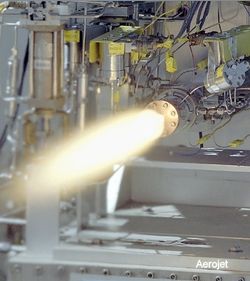Mon, Jul 06, 2009
Engine Designed For Lunar Ascent
 Aerojet announced this week that it
has completed manufacturing and assembly of an advanced 5,500-lbf
Liquid Oxygen (LOX) Liquid Methane (LCH4) rocket engine. Aerojet
will soon begin testing this advanced engine to provide data that
will validate the design features necessary to extend the
technology development of next-generation propulsion systems being
developed by NASA.
Aerojet announced this week that it
has completed manufacturing and assembly of an advanced 5,500-lbf
Liquid Oxygen (LOX) Liquid Methane (LCH4) rocket engine. Aerojet
will soon begin testing this advanced engine to provide data that
will validate the design features necessary to extend the
technology development of next-generation propulsion systems being
developed by NASA.
LOX Methane technology development focuses on rocket propellants
that are non-toxic as well as higher performing than many historic
propellant combinations. The 5,500-lbf Liquid Oxygen Liquid Methane
development engine is funded by the Propulsion and Cryogenics
Advanced Development Project (PCAD), under NASA's Exploration
Technology Development Program (ETDP). ETDP's role is to develop
and mature the necessary technologies to support flight systems in
NASA's Constellation Program, which includes engine development for
future lunar landers.
The lunar lander will be required to
send human explorers to the moon and return them to Earth. Unlike
the lunar missions during the Apollo program which encompassed days
on the moon, the missions anticipated for the lander may establish
a lunar outpost and extend lunar missions to months at a time.
The lunar lander is comprised of a descent and an ascent stage.
The descent stage will house the majority of the propellant, power
supplies and breathing oxygen for the crew. The ascent stage will
house the astronauts, their life-support equipment and necessary
fuel. The ascent main engine is anticipated to be expendable,
high-performance and pressure-fed, with the primary function of
powering an ascent module (AM) from the lunar surface into lunar
orbit for rendezvous with the Orion Crew Exploration Vehicle
(CEV).

File Photo
Multiple vehicle study activities have
shown that a cryogenic Liquid Oxygen (LOX)/Liquid Methane (LCH4)
propellant combination provides advantages for long duration
storage in space and for the ability to be extended for future
missions to Mars. This propellant combination is also being studied
as a promising option for the lunar lander's ascent stage due to
potential savings in overall systems mass when compared to
conventional propellant (hypergolic) systems. This new Liquid
Oxygen/Liquid Methane ascent main rocket engine is not as mature as
the conventional hypergolic systems. It uses non-toxic propellants
not previously used for this application and therefore tests are
needed to provide the critical design data. The Aerojet 5,500-lbf
Liquid Oxygen/Liquid Methane rocket engine program is designed to
provide the critical data for the AM application.
After Aerojet's initial tests, the engine will be delivered to
NASA's White Sands Test Facility in Las Cruces, New Mexico, where
the engine will be tested at a simulated altitude with a large
nozzle for performance characterization and for a long duration to
demonstrate the design's thermal adequacy.
More News
Also: Vertical Flight Society, NBAA Maintenance Conference, GA Honored, AMT Scholarship For the first time, students from Embry-Riddle’s Daytona Beach, Florida, campus took t>[...]
Hazardous Weather Information Summary of significant meteorological information (SIGMET/WS), convective significant meteorological information (convective SIGMET/WST), urgent pilot>[...]
"The need for innovation at speed and scale is greater than ever. The X-62A VISTA is a crucial platform in our efforts to develop, test and integrate AI, as well as to establish AI>[...]
(FAA) Inspector Observed That Both Fuel Tanks Were Intact And That Only A Minimal Amount Of Fuel Remained In Each Analysis: According to the pilot, approximately 8 miles from the d>[...]
“Pyka’s Pelican Cargo is unlike any other UAS solution on the market for contested logistics. We assessed a number of leading capabilities and concluded that the Pelica>[...]
 Airborne-Flight Training 05.09.24: ERAU at AIAA, LIFT Diamond Buy, Epic A&P
Airborne-Flight Training 05.09.24: ERAU at AIAA, LIFT Diamond Buy, Epic A&P ANN's Daily Aero-Term (05.07.24): Hazardous Weather Information
ANN's Daily Aero-Term (05.07.24): Hazardous Weather Information Aero-News: Quote of the Day (05.07.24)
Aero-News: Quote of the Day (05.07.24) NTSB Final Report: Cessna 150
NTSB Final Report: Cessna 150 Aero-News: Quote of the Day (05.08.24)
Aero-News: Quote of the Day (05.08.24)




